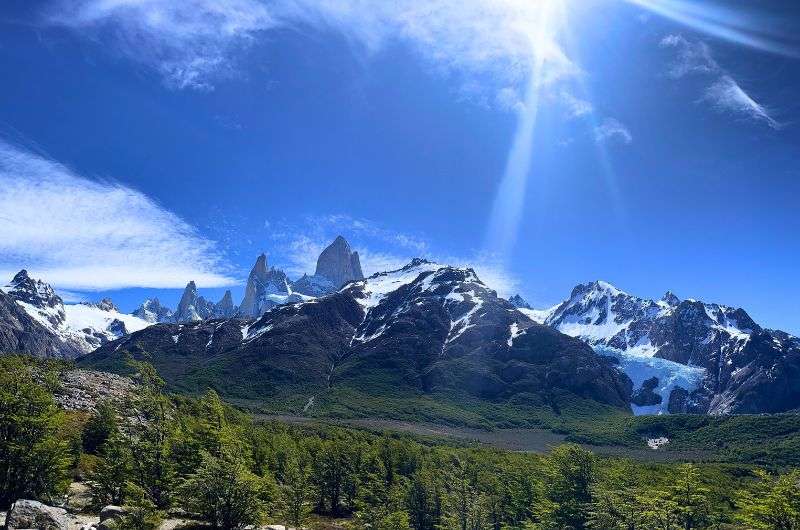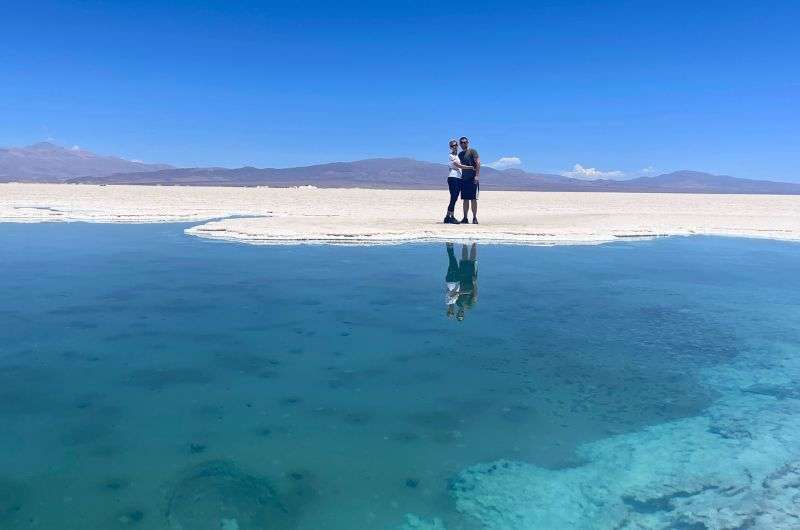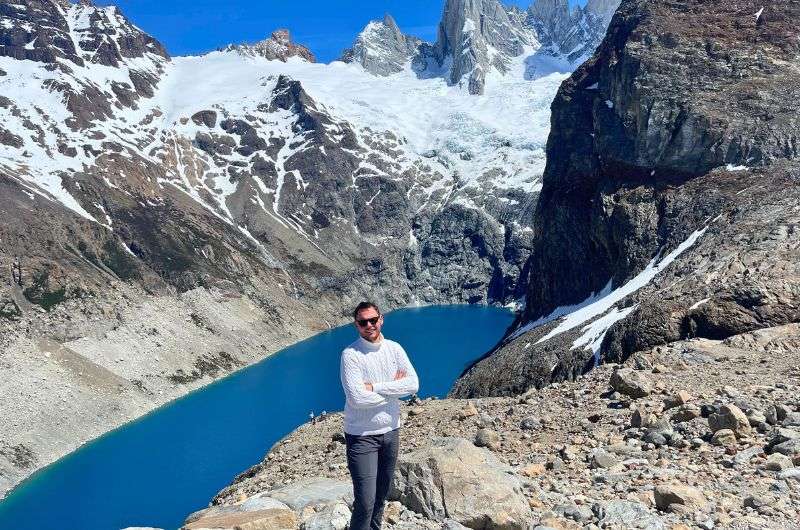Blue Dollar Argentina Explained: A How-to Guide for Tourists


Before I visited Argentina, I had visited over 50 other countries, and I must say that Argentina's rules and financial planning are really complicated. For me, the most dreaded question was about Argentina's Blue Dollar market.
When I was planning my first visit, I found most places so expensive when calculated in dollars. Then I bumped into the blue dollar thing which, when you finally grasp it, will make your visit to Argentina one of the cheapest destinations in the world.
>> See all of my Argentina guides and itineraries <<
The complexity of dealing with Argentine pesos and navigating exchange rates, especially the blue dollar, can be challenging but ultimately rewarding—and I mean that literally as well as financially. For example, a hotel that costs USD 500 at the official rate could cost just USD 130 at the blue dollar rate. That’s a huge discount! (Read more: Get tons of my tips on booking hotel rooms anywhere in the world.)
This blue dollar system, offering better rates to those with foreign currency, is particularly aimed at tourists, giving them a financial advantage while helping Argentina attract more international revenue.
In this article from my own experience, you will learn:
- What is Blue Dollar Argentina?
- How does the Blue Dollar work?
- Why are there two exchange rates in Argentina?
- What is the best way to pay for things in Argentina?
- Do credit cards get the Blue Dollar rate in Argentina?
- Arrival in Argentina: Los Arbolitos and how to find them
- Where to find good information about exchange rates?
- Practical use of Blue Dollar system for tourists
- Safety precautions for the tourists
- Is the Blue Dollar legal?

I’m not gonna lie, it was quite a challenge to figure out the Blue Dollar market before my trip to Argentina
Tip: Patagonia was worth every bit of head scratching to figure this Blue Dollar thing out. Get my 7-day itinerary for El Chaltén and El Calafate and see it for yourself. It’s a place like no other!
1. What is the blue dollar?
Simply put, the Blue Dollar is a semi-official exchange rate for the US dollar within the blue market, an informal and unregulated currency exchange system in Argentina. Because the Argentine peso (ARS) is officially pegged to the US dollar but loses value rapidly due to hyperinflation, the official rate doesn’t reflect the peso’s actual worth.

Argentine pesos
As locals are trying everything they can to get their hands on dollars, they will generally offer tourists much more favorable rates for them. This started as a cash-only system, but now hotels and even credit card companies like Visa and MasterCard now offer blue dollar rates. Details below.
2. Why are there two exchange rates in Argentina?
Argentina has two exchange rates because the Argentine government maintains a fixed exchange rate for the peso against the US dollar, instead of allowing it to float freely with market demand. Over time, the official rate failed to keep up with high inflation, widening the gap between the official rate and the real value set by the market. This led to the creation of a secondary “blue dollar” rate, which allows people to exchange pesos for dollars at a more realistic rate.

Understanding the Blue Dollar system is worth it. You wouldn’t want to miss places like Salta and Jujuy (we spent almost a week there!)
Historically, the Argentine government has seized or converted dollar deposits into pesos during financial crises, leading to widespread distrust in banks among citizens. This has resulted in a preference for cash transactions and alternative forms of wealth storage, as many Argentines feel insecure about the stability of their savings in the banking system.
3. What’s the best way to pay for things in Argentina?
It’s simple—you can use the unofficial exchange rate for Peso to USD transactions by mostly paying in Argentine Pesos. Here’s how:
- Credit card: Use your MasterCard and Visa Card—within a few days, the amount will be recalculated at the Blue Dollar rate.
- Cash: Pay in cash in pesos that you already got using the Blue Dollar rate (like from street changers called arbolitos).
- Western Union: You can use Western Union for Blue Dollar-rate pesos, but it’s complex to navigate (see below).

With so many bills, sometimes we felt like part of the mafia...
One problem is that you can’t really bring a lot of cash to Argentina, as it can be quite dangerous. The locals really want cash—really want it! Their currency loses value so quickly that by the end of the month, 10,000 pesos could be worth less than 7,000 compared to its value 30 days earlier. Imagine the horror of living with a currency like this.
4. Do credit cards get the Blue Dollar rate in Argentina?
Honestly, I wasn’t sure if paying with a card would work with the Blue Dollar rate—finding good info on this was hard. But right after I arrived, I discovered it works, and it’s the easiest system to use.
Here’s the deal: card companies realized they were losing money as tourists opted to pay for things in cash, and they really didn’t like that! So, they just came up with their own solution. With the recent policy change, foreign tourists can now use their foreign credit cards to access a more favorable exchange rate comparable to the unofficial Dolar Blue rate.

Buenos Aires

For you, that means you just pay with your credit card like you would anywhere else and they will give you the unofficial exchange rate of Blue Dollar. So much for the illegality of that...
How to use your credit card in Argentina
You need a credit card/debit card issued by MasterCard or Visa. Then, every time you pay with your card, you have to tell the cashier that you want to pay in Argentine Pesos. That way, you will get charged the correct exchange rate, and that's it. Wait, really? That’s it?! Yep.
The only problem is that you can't always pay by card, because in many hotels and restaurants they prefer payments in cash. This is because they get charged horrendous fees for card payments—as high as 20%! Imagine that while doing business in the EU/USA where you get charged something like 0,5-1% per payment.

5. Arrival in Argentina: los Arbolitos and where to find them
Los Arbolitos are the street moneychangers who offer the best unofficial exchange rates for USD to pesos. You’ll use them a lot as they are the only useful way to exchange cash for the Blue Dollar rate. (Actually, I’ll give you a tip for one more trick in a bit.)
If you arrive in Argentina in the evening, note that Buenos Aires’ airport doesn’t offer great cash options, so getting a hotel with a shuttle bus can save you from high taxi fares (like the Holiday Inn near the airport). Pay by card and that’s it for the day.
What if you arrive early? You can go to the center of the city and then do what I did: walk around the main square and find the people with backpacks full of money—they’re the los arbolitos, and in hindsight, you can’t really miss them!

Don't forget your money backpack!
Story time: The first time we tried to find arbolitos, we went to the main plaza in Salta and asked some elderly locals sitting below the palm trees if they had Blue Dollars. Awkward! This moment was the most stressful thing I could not prepare myself for in Argentina. My reasoning was that arbolitos, meaning “little trees” in Spanish, just HAD to mean that’s where you find them, right? Stupid me.
In reality, arbolitos are usually standing around in the corner of the square and when they see you are a tourist, they will find you. Just ask a few of them for the exchange rate and then choose the best one. They usually don’t differ that much, usually something like 2–5%. My strategy was to opt for the least sketchy-looking one.
They’re not really willing to exchange money in plain sight so you will sit together in a restaurant, you will give them your dollars, and they hand you the pesos. Like in normal exchange in any other country.

Seems illegal but it isn’t... sort of
You will need a sizeable backpack as the biggest ARS bills are quite small denominations, meaning you’ll end up with something like 1,5 million pesos in tons of bills—a literal backpack full of money. It’s very weird to walk around with a backpack meant just for money since you won’t be able to fit anything else in it. But that’s the reality of it!
Pro tips on exchanging money with arbolitos:
- Choose the least sketchy-looking ones to minimize risk of scams or theft. If anything feels off (who am I kidding, you’re already exchanging stacks of money with a stranger), don’t hesitate to walk away.
- Exchange up to USD 1,000 in one exchange. This way you won’t lose that much if they scam you.
- Don’t flash your cash as it might be the invitation for theft.
- Bring a big backpack—you will thank me later. I’m not kidding when I say you will get huge stacks of money.

Did we pretend to be millionaire slash mobsters who pull out a bundle of cash when they want to pay for dinner? Yes, we did. Was that responsible? Not quite...
6. One more trick: exchanging cash in Argentine hotels
You can exchange your dollars in some hotels as well. Some hotels I stayed at had their own "menu" with exchange rates. You will pay them in dollars for something meaningless and they will give you loads of pesos in exchange. They tend to have a slightly worse exchange rate than arbolitos. I am guessing it’s that way for their own safety.
At one hotel, we exchanged USD 500 into Argentine pesos on-site, then paid for our accommodation there in cash. This approach saved us around 70% compared to paying the full amount in USD directly.
7. Western Union and Blue Dollars
A third option and arguably the safest one is to send yourself money into Argentina through the Western Union mobile app and secure a favorable exchange rate that way. Then withdraw pesos in Argentina.

Laguna Torre
Follow these steps to get ARS from Western Union:
- Download Western Union mobile app—its painfully unintuitive, so be ready for it!
- After about two hours you will figure out how to send yourself money into Argentina.
- You will get a special code.
- Then, when you send your USD it will give you pesos at the Blue Dollar exchange rate.
- Once in Argentina, visit any Western Union branch and withdraw your ARS.
This is the safest option, but Western Union branches often run out of ARS, so be sure to go there first thing in the morning.
No worry, there are branches everywhere in Argentina. So, while it may take a few tries, you won't struggle too much to find one that’ll finally give you money.
8. Where do you find the official exchange rate?
Just type “dollar blue” into Google and the first URL that pops up there will lead you to the official and current exchange rate from USD to ARS with Blue Dollar rate.

Pesos
9. Practical use of Blue Dollars
Before you go to Argentina, send yourself at least USD 1,000 through Western Union so you are absolutely certain you’ll be able to get cheap money in Argentina. Once you arrive in the country, visit los Arbolitos once at the start of your vacation and then a second time in the middle. That way, you will always have cash.
Pay by card whenever and wherever you can. Just remember to use MasterCard or Visa and always choose to pay in ARS. Otherwise, you are not going to obtain the Blue Dollar exchange rate. The foreign tourist dollar rate also benefits tourists using foreign credit cards, allowing them to access a more favorable exchange rate for their transactions.
To be honest, I was really afraid of this Argentinian Blue Dollar rate invention and them somehow scamming me from my hard-earned money. But, after multiple visits, I found it to be one of the most amusing parts on my Argentina trips. You really are helping everyone by using the system: You help locals to get US dollars. You also help local businesses, local money dealers etc. And, no shame, you help yourself, too.

On our way to Laguna del Diablo
10. Safety precautions for tourists
When exchanging currency in Argentina, a little caution can go a long way to keep you (and your pesos) secure:
- Stick to Reputable Spots: Choose known exchange houses or Western Union. A quick online check for reviews can help avoid sketchy operations.
- Stay Aware: Avoid exchanging money in isolated or poorly lit areas; busy areas are safest.
- Count It Right: Double-check your cash before leaving. Mistakes can happen, and it’s better to catch them on the spot.
- Check for Counterfeit Bills: Familiarize yourself with Argentine bills to spot counterfeits.
- Keep Cash Secure: Use a secure bag and avoid carrying large amounts.
By following these, you’ll avoid currency exchange drama and focus on enjoying Argentina.
11. The impact of the Blue Dollar on Argentina’s economy
The Blue Dollar affects almost every part of Argentina’s economy:
- Inflation: When the Blue Dollar rises, imports become pricier as the peso falls, driving inflation up and making everyday goods more costly.
- Black Market: The Blue Dollar fuels the informal economy, allowing people to dodge official currency controls and creating a shadow economy outside government regulation.
- Economic Stability: A high Blue Dollar often reflects low public trust in the peso, signaling overall economic uncertainty.
- Foreign Investment: Navigating Argentina’s dual exchange rates is complex, which can turn off potential foreign investors, affecting long-term economic growth.
In short, the Blue Dollar’s rate reflects—and impacts—Argentina’s broader economic health, from inflation and imports to trust in government policy and daily living costs.

Salinas Grandes
12. Is the Blue Dollar legal?
The Blue Dollar operates in a murky legal space in Argentina, with some key points to keep in mind:
- Official Recognition: The Blue Dollar isn’t recognized by the Argentine government. Only the official exchange rate is acknowledged, while the Blue Dollar runs on a separate track.
- Government Stance: Despite its unofficial nature, the government largely tolerates the Blue Dollar, which has allowed it to thrive.
- Legality: While technically illegal, Blue Dollar exchanges are common and mostly low-risk, especially for tourists. Larger transactions can draw attention, but smaller exchanges are widely accepted.
- Practical Use: The Blue Dollar is simply a practical workaround for Argentina’s economic challenges, widely accepted by locals and tourists to get more value for their money.
For many, the Blue Dollar is simply a practical workaround for Argentina’s economic challenges, giving locals and visitors alike a way to navigate the economy.

Me and Laguna del Diablo
13. Final thoughts
The Blue Dollar is a wild ride and a key player in Argentina’s economy, and honestly, it’s essential intel for any tourist. Understanding how it works is the difference between getting by and getting ahead. Just keep your wits about you, brush up on the rules (official and “unofficial”), and remember that the Blue Dollar scene is always changing, so staying informed is a must. Whether the Blue Dollar sticks around or not, its impact on Argentine life—and your travel savings—is huge.
This post contains affiliate links. I earn a small commission if you make bookings through my links, at no additional cost to you. Thank you for your support!










Comments | Thoughts? Give us a shout!